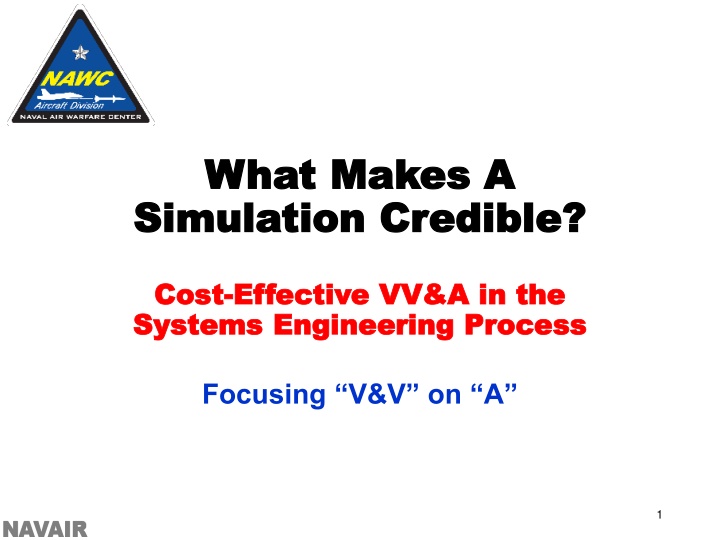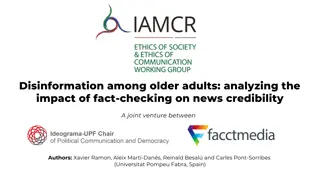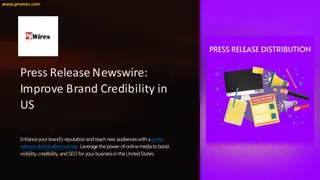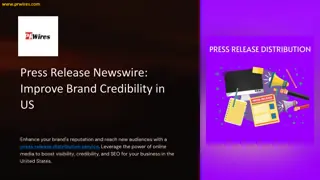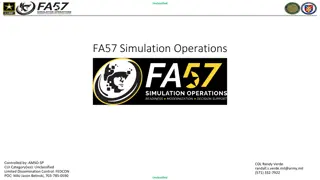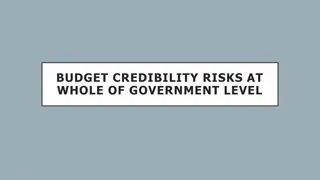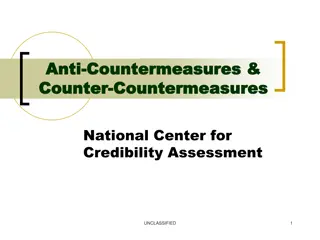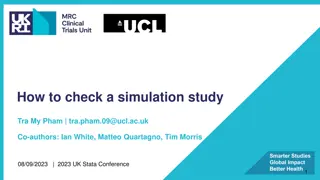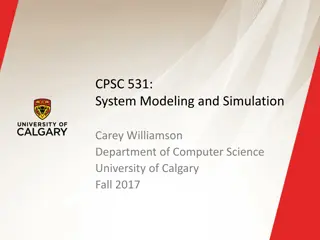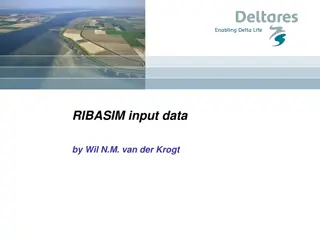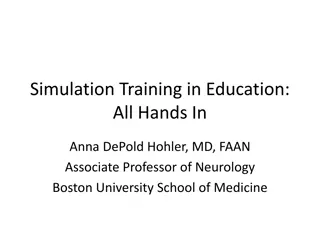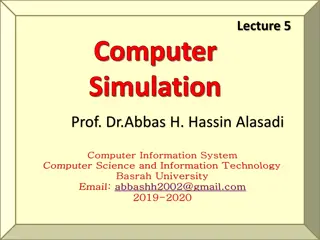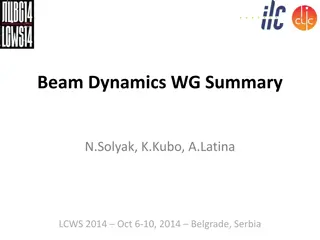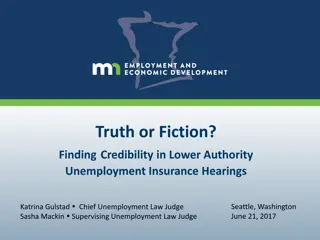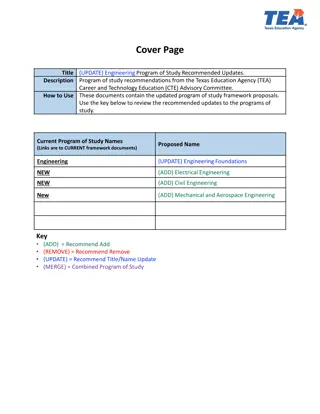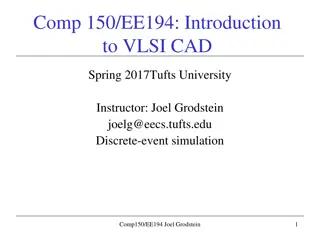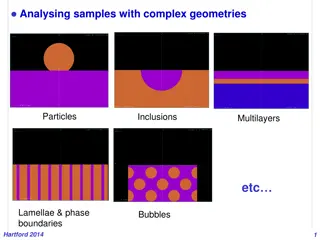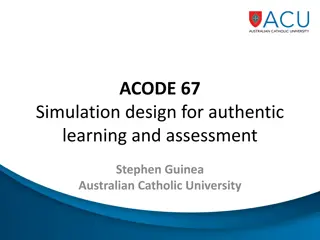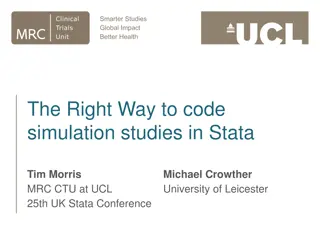Simulation Credibility in Systems Engineering Process
The significance of simulation credibility in the systems engineering process, focusing on cost-effectiveness and VV&A. Understand how NAVAIR uses risk assessment to determine the reliability of models and simulations. Learn about the processes of Verification, Validation, and Accreditation in M&S VV&A, and delve into defining M&S credibility to ensure accurate representation for decision-making."
Download Presentation

Please find below an Image/Link to download the presentation.
The content on the website is provided AS IS for your information and personal use only. It may not be sold, licensed, or shared on other websites without obtaining consent from the author.If you encounter any issues during the download, it is possible that the publisher has removed the file from their server.
You are allowed to download the files provided on this website for personal or commercial use, subject to the condition that they are used lawfully. All files are the property of their respective owners.
The content on the website is provided AS IS for your information and personal use only. It may not be sold, licensed, or shared on other websites without obtaining consent from the author.
E N D
Presentation Transcript
What Makes A What Makes A Simulation Credible? Simulation Credible? Cost Cost- -Effective VV&A in the Effective VV&A in the Systems Engineering Process Systems Engineering Process Focusing V&V on A 1
NAVAIR VV&A Process NAVAIR VV&A Process NAVAIR VV&A Branch uses risk to determine how much and what kind of information is needed to support using models and simulations (M&S) What is the risk to the decisionmaker if the M&S results are in error, but we use them anyway? What is the likelihood that the M&S is in error? How important is the decision? How much reliance are we placing on M&S results to make a decision? We develop a risk matrix based on the answers to those questions Using Likelihood of Error and Consequence of Error ratings Based loosely on the system safety risk assessment process We identify mitigation actions to reduce the risk to an acceptable level Those mitigation actions form the basis for Accreditation and V&V Plans Don t do any V&V that doesn t directly reduce the risk of using the M&S! 2
What is M&S VV&A? What is M&S VV&A? Verification:The process of determining that a model implementation and its associated data accurately represents the developer's conceptual description and specifications. Does the model do what the originator intended, and is it relatively error free? Did you build the model right? Validation:The process of determining the degree to which a model and its associated data are an accurate representation of the real world from the perspective of the intended uses of the model. How well do model results match real world data, in the context of your needs? Did you build the right model? Accreditation:The official certification [determination] that a model, simulation, or federation of models and simulations and its associated data are acceptable for use for a specific purpose. Does the accreditation authority have adequate evidence to be confident that a model is fit for purpose? Did your customer accept it as sufficiently credible to be fit for purpose? 3 Definitions from DODI 5000.61 dated 13 May 2003
M&S Credibility M&S Credibility ? What is M&S Credibility ? How is it Measured ? How Much Credibility is Enough ? How Does All This Relate to VV&A ? 4
How Much Credibility How Much Credibility Is Enough ? Is Enough ? It Depends on Risk M&S User A Makeshift Bridge is Good Enough If You Need To Cross a Meandering Shallow Stream M&S CREDIBLE SOLUTION PROBLEM BUT 5
Greater Risks... Greater Risks... Indicate the Need for Evidence of Greater Credibility M&S Supporting Evidence CREDIBLE SOLUTION PROBLEM 6
What Makes a What Makes a Simulation Credible ? Simulation Credible ? Most people think Validation (AKA Output Accuracy ) is the hallmark of simulation credibility The degree to which simulation outputs match the real world There are three ways to define the Real World 1. Benchmarking Another simulation with established credibility 2. Face Validation Subject Matter Expert (SME) expectations 3. Results Validation Test Data But each of these have well-known limitations Uncertain benchmark simulation credibility Disagreements among SMEs Test data availability, limitations & cost Fortunately, there are other measures of simulation credibility we can add to Validation 7
V&V: The Central Pillars V&V: The Central Pillars of Simulation Credibility of Simulation Credibility S/W Accuracy Data Accuracy Output Accuracy Simulation meets design requirements, operates as designed and is free of errors in software Simulation input data, validation data and data manipulations are appropriate and accurate Simulation outputs match the real world well enough to be of use in a particular problem Software (S/W) Accuracy Data Accuracy Output Accuracy Verification "V" "V" Validation "V" "V" & & V&V are Just the Middle of the Bridge! 8
The Other Pillars of The Other Pillars of Simulation Credibility Simulation Credibility Usability Capability Simulation has adequate user support to facilitate correct operation and interpretation of its outputs Simulation possesses all required functionality and fidelity for the problem being solved Ties the M&S to a Useful Solution Anchors the M&S to the Problem M&S Usability Accuracy Capability M&S User Requirements Capabilities Credible Solution Problem How Accurate are: Software Data Output? Can I Be Sure I m Not Mis- Using the M&S? Does the M&S Do What I Need It To Do? 9
The Simulation The Simulation Credibility Equation Credibility Equation Credibility = f (Capability, Accuracy, Usability) Capability Functional and Fidelity Characteristics Assumptions & Limitations Accuracy Software, Data, Outputs Usability Training, Documentation, User Support Appropriate Hardware & Software V&V 10
Accreditation is a Decision Accreditation is a Decision An official determination that a model, simulation or federation of simulations is credible enough and suitable for a specific application Accrediting authority needs to provide justification for selection and use of a given simulation for a given problem to reduce program risk in using the M&S . . Without adequate evidence, you re out on a limb using model results M&S USER 11
Evidence Supporting Evidence Supporting Accreditation Accreditation V&V products provide essential information that contributes to simulation credibility Software, data and output accuracy BUT V&V alone are insufficient to support accreditation Capability and Usability requirements must also be addressed DoD, Service, and Agency policies all require evidence of some aspects of capability and usability M & S USER Evidence of capability, accuracy and usability gives you a solid base for confidence in model results V&V Evidence Capability & Usability Evidence 12
The Essence of Accreditation The Essence of Accreditation IDENTIFY DEFICIENCIES M&S CREDIBILITY REQUIREMENTS M&S CREDIBILITY INFORMATION Capability Accuracy Usability Data Quality M&S Documentation Design Documentation Configuration Mgt V&V Results Etc. IDENTIFY WORK-AROUNDS, USAGE CONSTRAINTS, REQUIRED IMPROVEMENTS AND RISKS Defined by the User (Formally or Implied) Provided by the Model Developer and/or Model Proponent ACCREDITATION DECISION PROBLEM CONTEXT TO DEMONSTRATE THE M&S IS SUITABLE FOR THE NEED REQUIRES AN OBJECTIVE COMPARISON OF M&S REQUIREMENTS WITH M&S INFORMATION WITHIN THE CONTEXT OF THE PROBLEM THAT IS ADEQUATELY DOCUMENTED 13
V&V is a Process V&V is a Process Accreditation is the Accreditation is the Decision Decision Risk is the Metric Risk is the Metric V&V is a rheostat gradually shining light on the problem: how much light you need depends on the risks of using M&S results If you need to stumble to the bathroom in the middle of the night: You only need a little light to keep from stubbing your toe on the dresser If you need to shave before that big interview: You need more light to avoid cutting yourself If you re performing brain surgery: You need a lot of light to keep from killing someone! If you re developing system requirements: You may only need a little information to support M&S use early in the program If you re demonstrating specification compliance: You need to be pretty sure the M&S works right, so you don t have to absorb redevelopment costs if it leads you to the wrong design If you re into Operational Test & Evaluation: You need to demonstrate and document that the M&S works right or the OTD may cancel your system as unsuitable or ineffective! 14
NAWCAD IBST NAWCAD IBST Risk- -Based VV&A Process Based VV&A Process Risk Conduct Preliminary Risk Assessment Develop M&S Requirements (Capability, Accuracy, Usability) Develop Intended Use Statement and Articulate Program Requirements Define Acceptability Criteria and Metrics for the M&S Requirements Prepare M&S Management Plan or M&S Support Plan Develop Accreditation Plan (Capability, Accuracy, Usability) SME Support VV&A Team Support SME Support Conduct Risk Assessment Execute V&V Activities Develop V&V Plan (Capability, Accuracy, Usability) Write V&V Report Write Accreditation Report and Make Recommendation Evidence Sufficient ? Yes No Update V&V Plan Program Manager Model User Model Developer Prepare and Issue Accreditation Decision Letter Subject Matter Experts M&S Accreditation Decision Review Accreditation Package VV&A Team Accreditation Authority 15 VV&A Team Support SME Support
Intended Use Statement Intended Use Statement The Intended Use Statement describes the questions you re trying to answer and the problem you re trying to solve Indicates specifically how M&S will contribute to the solution Developed through extended conversations between M&S developers, analysts and users Essential first step M&S Requirements document the M&S characteristics necessary to be suitable for the intended use Functionality, fidelity, operating environment, input data, etc. Acceptability Criteria and Metrics Define in detail how you ll decide if the M&S meets your needs Information Requirements document the information the decision maker needs in order to accept the M&S as credible and suitable Influenced by policy, personal experience, expert advice 16
Focus V&V on M&S Focus V&V on M&S Intended Uses Intended Uses A lot of money is misspent on V&V activities Cost-effective V&V needs to focus on addressing: What questions do the users need to answer? What M&S outputs will be used to help answer those questions? What characteristics must the M&S have to provide those outputs? Capability, Accuracy, Usability What information is needed to show the M&S has those characteristics? V&V results, CM artifacts, documentation, pedigree, etc. What information is missing, and how can we best develop it? What are the risks of not obtaining that information? V&V should be tied to intended uses through requirements Eliminate any M&S requirements that are not relevant to the specific intended use VV&A Team may need to help the user derive: Detailed intended use statements Requirements tied to those uses Ultimate Goal: Reduce the Risk of using M&S To an acceptable level for the intended use ? 17
Example of A General Example of A General Intended Use Statement (IUS) Intended Use Statement (IUS) Intended Use for Traffic Flow Model (TFM)* The Traffic Flow Model (TFM) will simulate a standard 4-way intersection in order to provide analysis of traffic flow control and provide support for implementing improvements in redirecting congestion. The TFM will be applied for the following uses: To estimate the performance level of current traffic control systems to efficiently dissipate high density traffic congestion. To simulate variations of traffic flow situations in a naval base environment. To determine the effect of altering traffic control systems. TFM will be further developed in the future with increased complexity and fidelity to represent the entire traffic system of PAX NAS. * Created by NAVAIR 5.4 VV&A Team Employees and Interns as part of a study project on How to Build a Credible Simulation 18
Specific Intended Uses for Specific Intended Uses for Traffic Flow Model (TFM) Traffic Flow Model (TFM) Key Questions to Be Addressed by M&S What is the efficiency of the current traffic control system at a single intersection of PAX NAS? Intended Use Application Model Outputs/Data Determine the necessity of further management of high traffic density at this single intersection. Traffic queue lengths Queue wait times Traffic flow rates (Based on time of day and present traffic light settings) The Model & Simulation (M&S) will be used to simulate traffic flow at a standard 4-way intersection on PAX NAS. What is the current representative traffic density at the designated intersection? Determine the baseline for traffic improvement. Traffic queue lengths Queue wait times Traffic flow rates (Based on time of day and present traffic conditions) What is the effectiveness of the current traffic light cycle and timing at representative intersection? Determine effectiveness of traffic light function when compared to present traffic congestion. Present traffic light timing, and cycle patterns How can optimal traffic flow be maintained through control of traffic light functions at a given intersection? Determine optimal light cycle timing to efficiently dissipate high density traffic. Independent/ User Controlled Variable o Adjustable light cycle time intervals Dependent Variables o Traffic queue lengths o Queue wait times o Traffic flow rates. Multiple representative traffic intersections Traffic light cycle timing capable of acting as independent elements or as a part of a system. The M&S will be used to support improvement of traffic flow at single intersection of PAX NAS. How can the modeling of a single intersection of PAX NAS be expanded to model all traffic lights on base? Determine how traffic lights on base intersections can be managed to work both independently and as a system to optimize traffic flow. The M&S will be used to support future modeling and evaluation of the entirety of PAX NAS traffic congestion. 19
M&S Requirements, M&S Requirements, Acceptability Criteria, Acceptability Criteria, Metrics & Measures Metrics & Measures M&S Credibility Requirements flow from the intended use Does the M&S do what you need it to? What capability (functionality & fidelity) is required? How will you evaluate that? How accurate do the results need to be? Software Accuracy (including verification results) Data Accuracy (input and embedded data V&V) Output Accuracy (validation results) How will you evaluate all of those? What needs to be in place to ensure that it is used properly? Configuration Management, Documentation, User support How will you evaluate those? 20
M&S Requirements, M&S Requirements, Criteria and Metrics Criteria and Metrics M&S Requirements Acceptability Criteria Metrics/Measures Capability: functional and fidelity characteristics required Documented specific details of requirements for design and data, and appropriate output parameters Review of requirements and design, complete documentation, outputs are appropriate to the need Software Accuracy: S/W is adequately tested Appropriate and documented S/W environment, testing and verification Review of verification and testing results and S/W development environment Data Accuracy: input and embedded data are appropriate and documented Authoritative input data sources, documented data V&V, verified data transformations Review and acceptance of documented data V&V and sources Output Accuracy: outputs are of sufficient accuracy for the application Dynamic behaviors are appropriate; compares to benchmarking, SME expectation and/or test data Review and acceptance of validation results important to the intended use Usability: processes and documentation are in place to ensure proper operation and interpretation of outputs CM is adequate and demonstrated; users are appropriately trained and supported; documentation is adequate for use Review and acceptance of documented processes and demonstration that they are being followed 21
Specific Acceptability Criteria Specific Acceptability Criteria & Metrics & Metrics 6 6- -dof Example dof Example M&S Requirement Acceptability Criteria Metrics/Measures A. Atmospherics A1 Simulate turbulent environmental conditions using either the von Karman or the Dryden Formulas A2 Simulate the air vehicle response to varying levels of wind gusts B. Air Vehicle A1 The M&S incorporates either the Von Karman or the Dryden form of turbulence model A1 SME review of comparisons between the wind output data (aircraft velocity, etc.) from the selected turbulence model and the expected turbulence form (Von Karman or Dryden) A2 SME review comparing the wind output data (aircraft velocity, altitude, wind velocity, etc.) from the gust model with expected gust model results A2 The M&S incorporates an ability to induce varying strength gusts onto the air vehicle B1 Simulate mass properties of the Air Vehicle B1.1 The M&S accepts a mass properties database B1.1 SME review of documentation describing the process to incorporate a mass properties database file B1.2.1 Verify that the mass property parameters output from the M&S agree with the expected output according to the database model B1.2 Mass property parameters output from the M&S agree with the expected output according to the database model B1.2.2 SME Review of documentation supporting the validation of the process used to create mass property database files (mass property model) 22
Its Hard to Conduct V&V It s Hard to Conduct V&V Without Requirements Without Requirements It s easy to look like you re making progress if you don t know where you re going Example: V&V of M&S that predicts Effective Time-on-Station (ETOS)* Issue: The program had an intended use statement but no M&S requirements: this created many issues with verification as well as with the software The program office was changing requirements during M&S development The developer and the program office had no consensus on M&S requirements A software requirements document serves as an agreement between the program office and the developer No software design requirements document meant there were no testable requirements for verification Solution: We worked with the developer to create software design requirements These software design requirements were used as testable parameters to create an implementation test procedure Each requirement was matched with corresponding test(s) * ETOS is defined as the total time the mission area is covered by an aircraft on station, divided by the total coverage time required 23
Initial Risk Assessment Initial Risk Assessment INITIAL IDENTIFY DEFICIENCIES M&S CREDIBILITY REQUIREMENTS M&S CREDIBILITY INFORMATION Data Quality M&S Documentation Design Documentation Configuration Mgt V&V Results Etc. Capability Accuracy Usability IDENTIFY WORK-AROUNDS, USAGE CONSTRAINTS, REQUIRED IMPROVEMENTS AND RISKS Defined by the User (Formally or Implied) Provided by the Model Developer and/or Model Proponent PROBLEM CONTEXT The Initial Risk Assessment identifies information gaps, risks and guides the V&V Plan 24
NAVAIR M&S Risk NAVAIR M&S Risk Assessment Process Assessment Process Specific Likelihood of Error (2) Overall Likelihood of Error (4) General Likelihood of Error Overall Risk (3) (8) Level of Reliance on the M&S (5) Level of Consequence of M&S Error (7) Level of Importance of the M&S (6) 25
Error Likelihood Assessment Error Likelihood Assessment Error Likelihood is based on assessment of ten characteristics: 1. 2. 3. 4. 5. 6. 7. 8. 9. 10. User Support Functions Well defined Intended Use and Acceptability Criteria Conceptual Model Validation Model Fidelity assessment WRT intended use Software Design Validation Input and Embedded Data V&V System/Software Verification Output Validation Documented and Demonstrated Configuration Management Complete and up-to-date Documentation 26
Error Consequence Error Consequence Assessment Assessment Error consequence based on how much reliance is placed on M&S results for decision-making and how important the decision is to program objectives Reliance level is based on how much information is available (other than the M&S) to support the decision: Will M&S be the ONLY source of information, or the primary method supplemented by other data, or a secondary method, used to supplement other data, or a supplementary method only? Importance level is based on the level of program decision involved (ORD threshold, KPP resolution, etc.) and/or on importance levels as described in MIL-STD-882 (systems safety) 27
Reducing the Risk of Reducing the Risk of M&S Use M&S Use V&V Results 5 Error Likelihood Improve M&S Credibility 4 3 2 1 1 2 3 4 5 Risk Reduce reliance on M&S results Reduction Strategies Error Consequence Low Moderate High Risk = Likelihood x Impact 28
VV&A Planning VV&A Planning Establish Risk Levels For Each Application Identify Risk Types Determine Impacts and Likelihoods Determine Risk Level Determine Appropriate Information Products Needed based on risk AIRGuide = Accreditation Information Requirements Guide Helps prioritize V&V tasking based on an assessment of risk levels For Each Credibility Component (Capability, Accuracy, Usability) Greater Risk Levels Dictate More In-depth Information and more formal documentation Based on interviews with 40+ programs and refined over 25+ years of use Determine Appropriate V&V Activity For Each Information Product and develop V&V Plan 29
Correlating Risk with Correlating Risk with V&V Activities V&V Activities Type, Scope and Depth of Information Required When Risk Is M&S S/W Accuracy Issue Items Required Typical Sources Low Moderate High S/W development and maintenance process description S/W development and management resources description How much confidence do you have in the accuracy of the software? S/W development and management artifacts and documentation Module, subsystem and system S/W test reports; S/W Problem Change Request (SPCR) logs that correlate verification results with specific versions of the S/W; alpha- or beta- test reports; specific verification reports for the M&S version being used. IV&V reports System, subsystem and module level verification test documentation is required. IV&V results are desirable. System and subsystem level verification test documentation is required. System level verification test results desirable. S/W verification results S/W Quality Assessment Example from Accreditation Information Requirements Guide (AIRGuide) AIRGuide covers M&S Capability, Accuracy & Usability Issues AIRGuide requirements are based on interviews with 40+ DOD Programs 30
Accreditation Information Accreditation Information Requirements* Requirements* (for initial assessment of moderate risk) (for initial assessment of moderate risk) Software (S/W) Accuracy: Capability: Functional breakdown and description of simulation Summary of assumptions, limitations and errors Usability: Demonstration of the computer hardware and operating system suitability Evidence of proper interface and operation of pre- and post- processors Operator qualifications Analyst qualifications Availability of user support services Usage/accreditation history S/W development and maintenance process description S/W development and management resources description S/W development and management artifacts and documentation S/W verification results S/W Quality Assessment Data Accuracy: Indications of data quality Indications of quality assurance in the data generation process Indications of data manipulation accuracy Output Accuracy: Benchmarking Results Face Validation Results Results Validation Documentation Sensitivity Analysis Results (* From AIRGuide) 31
ETOS M&S V&V Example ETOS M&S V&V Example V&V began with ETOS M&S Version 1: Verification test procedures were developed using the software requirements document we created Multiple errors were discovered and documented Software Quality Assessment (SQA) was performed via manual code review Relatively small code Biggest issue was lack of objects Subject Matter Expert (SME) Review was performed Verification errors were confirmed Sensitivity analyses were reviewed In general, SMEs agreed that M&S was realistic enough for the intended use if known errors were corrected The developer addressed multiple errors (bugs) Developer can address software issues using the following justifications: User Error, Software Test Error, Software Requirements change, No Fix and Software Update All major bugs should be fixed through a software update. Non major bugs can become new assumptions, limitations or known issues V&V continued with ETOS M&S Version 2: Verification test procedure was used again Multiple new errors were discovered Corrected in Version 3 OK 32
Effective V&V Calls for Effective V&V Calls for a Team Approach a Team Approach It works best when everybody pulls together Each team member brings different expertise: Developer knows the specific M&S V&V Team knows cost-effective V&V principles SME know the technical area But they don t always work and play well together Developer can get defensive about their M&S V&V Team can be perceived as hyper-critical SME can get stuck on, I d have done it this other way V&V Works best when: V&V Team objective is to help the M&S work for the user Developer recognizes the benefits of V&V improving the M&S SME make constructive suggestions based on review of sensitivity analyses and all V&V results All V&V activities focus on reducing the risk of using the M&S for the specific intended use 33
Accreditation Accreditation An Accreditation Decision is based upon an assessment Using information available from existing resources and the results of any new V&V, does the M&S meet the acceptability criteria for the application? What workarounds are needed for the application? Is there adequate supporting documentation? What is the residual risk remaining after all VV&A results are in? The user, the program office and the M&S developers need to work in cooperation to develop a meaningful accreditation case 34
Specific Capability/Accuracy Specific Capability/Accuracy Assessment Assessment 6 6- -dof Example (SME Review) (SME Review) dof Example M&S Requirement Acceptability Criteria Metrics/Measures Assessment A. Atmospherics A1 Shall simulate turbulent environmental conditions using either the von Karman or the Dryden Formulas A1 The M&S incorporates either the Von Karman or the Dryden form of turbulence model A1 SME review of comparisons between the wind output data (aircraft velocity, etc.) from the selected turbulence model and the expected turbulence form (Von Karman or Dryden) A2 SME review comparing the wind output data (aircraft velocity, altitude, wind velocity, etc.) from the gust model with expected gust model results Inspection has been documented; SME review identified no issues from a flying quality perspective; turbulence is subjective, and SME are supportive of what s in the model. Acceptable A2 Shall simulate the Air Vehicle response to varying levels of wind gusts A2 The M&S incorporates an ability to induce varying strength gusts onto the Air Vehicle Government and contractor SME are in agreement on how to handle gusting for purposes of spec compliance: Acceptable B. Air Vehicle B1 Shall simulate mass properties of the Air Vehicle B1.1 The M&S accepts a mass properties database B1.1 SME review of documentation describing the process to incorporate a mass properties database file B1.2.1 Verify that the mass property parameters output from the M&S agree with the expected output according to the database model Documentation meets the requirement per SME Review: Acceptable B1.2 Mass property parameters output from the M&S agree with the expected output according to the database model The V&V Report provides a clear-cut example of how they match. The SMEs are comfortable with mass properties representations in documentation. One additional document should be added to the list of supporting references to be provided. Acceptable B1.2.2 SME Review of documentation supporting the validation of the process used to create mass property database files 35
SME Reviews of Sensitivity SME Reviews of Sensitivity Analyses Can Help Support the Analyses Can Help Support the Accreditation Case Accreditation Case (ETOS Example) (ETOS Example) Have the experts tell you if the results look suspect Example: Effective Time on Station (ETOS) should increase monotonically with endurance Sensitivity Analysis revealed a bug: M&S called vehicle back from sortie for scheduled maintenance, and re-launch would have been at night (deck closed for 12 hours); scheduled maintenance events should wait until sortie is completed That bug had not been identified by other V&V activities 36
Summary Summary VV&A is a risk reduction/mitigation process Accreditation means comparing your credibility requirements for a simulation with what information you can gather about it, and assessing the residual risk of using it Credibility = Capability, Accuracy, Usability We ve developed a cost-effective way to gather the information required to support an accreditation decision Focus V&V activities on the Intended Use Make maximum use of existing (although possibly undocumented) information Use SME reviews to assess and document overall M&S credibility related to the intended use 37
Backups Backups 38
VV&A Documentation VV&A Documentation Requirements Requirements DRAFT SECNAVI 5200.40A DMSO VV&A RPG AFI ARMY AR 5-11 SECNAVI 5200.40 DODI 5000.61 ARMY PAM 5-11 DOCUMENT 16-1001 V&V PLAN X X X X V&V REPORT X X X X X X X ACCREDITATION PLAN X X X X ACCREDITATION REPORT X X X X X X X SIMULATION SUPPORT PLAN X METADATA TABLES X X 39
M&S Points Of View M&S Points Of View Typically works for the M&S User Funds the development, (or modification) and use of M&S for his specific application. Manages the M&S development effort. Ensures that the User s M&S requirements are accurately captured and implemented in software. Has the most to lose if M&S results aren t believable. M&S USER M&S PROGRAM MANAGER Typically works in support of the M&S User. Simulation Proponent Accreditation Authority Ensures that V&V and other evaluation efforts support accreditation of M&S for specific applications. V&V AGENT ACCREDITATION AGENT M&S DEVELOPER Typically works for the M&S Program Manager Typically works for the M&S Program Manager. or the User Builds the software. Ensures that M&S Developer plans, conducts and documents V&V activities Performs V&V activities. appropriately. 40
M&S User/Accreditation M&S User/Accreditation Authority Authority Responsibilities for VV&A: Define the intended use and resulting M&S requirements Define the information required to perform an assessment of a simulation for accreditation Perform final accreditation assessment and make accreditation decision Frequent Weakness Lack of knowledge of policy and reasonable practice in VV&A Lack of technical knowledge necessary to develop meaningful and sufficient requirements for M&S Lack of experience and gut feel necessary to determine what kind of correlation one should reasonably expect to see between good test data and simulation predictions for parameters of interest VV&A is incidental to their major activities (e.g., planning and conducting an OT&E program) 41
Accreditation Agent Accreditation Agent Responsibilities for VV&A Work with user and developer to ensure that the ASP is sufficient to support a meaningful accreditation assessment for the application Facilitate communication between different communities Provide up-to-date information on current policy and best practice Provide insight into cost/benefit trade of various V&V and documentation activities Frequent Weaknesses Lack of detailed understanding of specific technical areas relevant to the M&S or the particular application May overlook value of existing informal documentation May not have sufficient authority to task individuals or establish priority of V&V related work May lack knowledge of policy and standard practice within the agencies represented by the M&S developer, M&S proponent, and/or end user ? ? 42
M&S Developer M&S Developer Responsibilities Responsibilities Develop M&S in a professional, disciplined manner Maintain documentation of the M&S development Plan, execute and document V&V required to show that the M&S meets its original requirements Maintain effective configuration management Support accreditation efforts by providing users with information Provide expertise on the characteristics of your M&S Assist in creation of an Accreditation Support Package (ASP) 43
Frequent Weaknesses of Frequent Weaknesses of M&S Developers M&S Developers May have difficulty separating aspirations for the M&S from what finally evolved May not have funding to do formal documentation M&S Features and Manuals V&V Activities May not understand User s application for the M&S May be defensive about requests for objective evidence of the quality of his product There is often a perception of bias in defending the M&S even if the developer has a very even view 44
How The Developer Can How The Developer Can Help the User/Accreditation Help the User/Accreditation Authority Authority Develop a straw-man set of M&S requirements based on the intended use Provide adequate documentation of V&V activities Even if informal Offer suggestions on comparing simulation predictions with test data How close the correlation must be for a given application How close one can reasonably expect the correlation to be given the uncertainties of testing 45
How the Developer Can Help How the Developer Can Help the Accreditation Agent the Accreditation Agent Provide technical support You are the expert in the area Show the agent your records and describe any V&V work done in the past And any local practices related to simulation development and V&V Produce at least informal documentation of V&V activities as part of the development process 46
Whats the Issue with What s the Issue with Documentation? Documentation? Everybody DOES some V&V to convince themselves that their M&S works correctly But almost nobody writes it down In a well documented, retrievable fashion So they can convince someone else They may not think of what they re doing as V&V Documentation is lower priority than completing the code And it isn t as much fun Accreditation decisions must be backed up by evidence It s hard to do with no documented V&V record Can t rely on corporate memory People forget, leave, move on to other projects, etc. Documentation is time consuming and requires funding But documentation that doesn t keep pace with development is worthless 47
V&V Documentation Doesnt V&V Documentation Doesn t Need to Be Formal Need to Be Formal Example: A Mission Effectiveness Model Developer initially said he had done no V&V and had no configuration management (CM) process However, we rummaged thru his files and found informal test reports, PowerPoint briefings and notes describing software test results going back over 20 years He was able to trace versions throughout development, since he was the only developer and the principal user We documented the results he had, added some V&V results of our own, and recommended a CM process that he implemented The ultimate user accredited the M&S based on that evidence 48
How to Better Use How to Better Use Documentation You Documentation You Already Have Already Have Information that supports accreditation often already exists, but is not complete or retrievable Briefings, meetings, peer reviews, notes Necessary accreditation documentation Often can be created without too much effort Focus on Content, not appearance Note references on existing briefings Just hand-write them on the hardcopy if you have to Write down which version of the simulation each briefing relates to, and which version of the hardware (if you re modeling a real system) Keep resumes of all team members Document Team Qualifications Summarize in Accreditation Support Package (ASP) Record Keeping 49
Accreditation Support Accreditation Support Package (ASP) Package (ASP) An Easy, Scalable, Consistent Approach to Credibility Documentation Information elements were selected from surveys of accreditation authorities And refined over more than 20 years of use An unclassified (usually) compilation of the information most needed to support accreditation Organized around the three aspects of M&S credibility Capability, Accuracy, Usability 50
